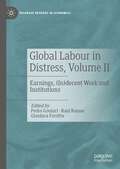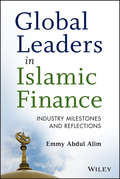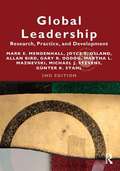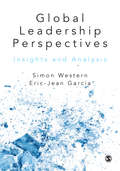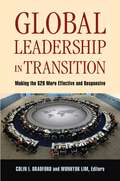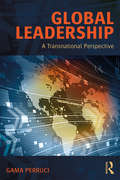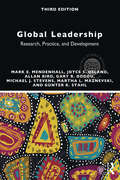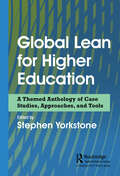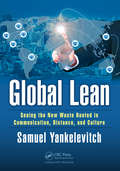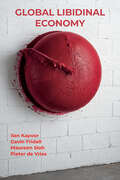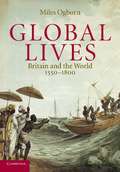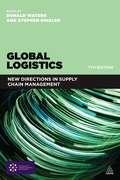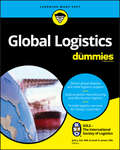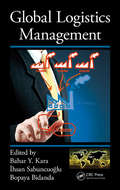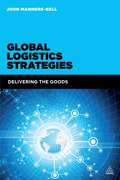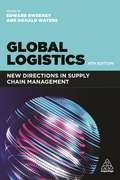- Table View
- List View
Global Labour in Distress, Volume II: Earnings, (In)decent Work and Institutions (Palgrave Readers in Economics)
by Pedro Goulart Raul Ramos Gianluca FerrittuThis book, the second of two volumes, explores the transformations to the labour market observed since the offi cial end of the Cold War in 1991. This period is defi ned by the retreat of the state and a move towards more market-based economies, followed by a State comeback with the Great Recession. These bumpy decades for labour and changing labour policies are analysed thematically. The second volume focuses on labour earnings and inequality, underemployment, (in)decent work, and labour market policies. This book aims to examine how labour institutions, both in developed and developing countries, have responded to the challenges faced over the last 30 years. It will be relevant to students and researchers interested in labour economics, political economy, and development economics.
Global Leaders in Islamic Finance
by Emmy Abdul AlimInterviews with the professionals driving the rapid global growth of Islamic financeThough the modern Islamic finance system has existed for more than forty years, its size and influence in the banking industry has expanded massively in just the last decade. This book looks at Islamic finance from the perspective of the experts shaping the industry, including some of the founders of the first Islamic banks--Haj Saeed Lootah, His Royal Highness Prince Mohamed Al Faisal Al Saud, and Sheikh Saleh Abdullah Kamel--as well as other professionals who have greatly influenced the industry. Editor Emmy Alim offers rare insight on Islamic finance with these insightful interviews focused on the development, rise, and future trajectory of Islamic finance.Features rare insider perspective on the rise of Islamic finance with interviews from the top names in the industry in Asia, the Middle East, Europe, and the United StatesAn ideal resource for bankers and finance professionals working in traditional finance as well as Islamic financeWritten by Emmy Alim, Editor for Thomson Reuters Islamic Finance Gateway, a multi-platform forum for experts and professionals in the Islamic finance industry
Global Leadership 2e: Research, Practice, and Development
by Michael Stevens Günter K. Stahl Martha L Maznevski Gary R. Oddou Mark E. Mendenhall Allan Bird Joyce OslandGlobal leadership has been frequently heralded by writers and executives as the key to sustained competitive advantage on the part of organizations. In addition, it is clear that the possession of leadership qualities and the display of leader behavior are requirements for individuals attempting to progress in their careers. It is important for aspiring managers to learn about the nature of effective global leadership and how they can develop their own competencies in this area. This textbook provides an important overview of this key emerging area within business and management. Offering a view into the nature of global leadership and the competencies necessary for aspiring managers to succeed, Global Leadership is essential reading for students of leadership, organizational theory, strategic management, human resource management, and for anyone working and managing in the global arena. Now in its second edition, it draws from recent research to both contemporize timeless topics and address today's relevant topics, from corporate social responsibility, to cultural competencies, to current technology.
Global Leadership Perspectives: Insights and Analysis
by Simon Western Éric-Jean GarciaA critical, global counterpoint to more western-centric texts that will appeal to critical leadership scholars, those teaching leadership from a critical perspective and those teaching leadership with an international focus. Split into two parts; its first part presents the local and regional variations in leadership from across the globe, with each of the twenty individual authors presenting the histories, cultures, tensions and social changes that shape the practice of everyday leadership in their respective region. Regions and countries included are: the Arab Middle East, Argentina, ASEAN, Australia, Brazil, China, Democratic Republic of Congo, Ethiopia, France, Germany, India, Japan, Mexico, Poland, Russia, Scandinavia, South Africa, Turkey, UK, USA. In the second part, the editors then critically analyses these chapters and identify the key themes and specific issues, enabling the reader to challenge their own leadership perceptions and move beyond the normative, uncritical approach to leadership. Suitable reading for leadership students, researchers and practitioners looking to enhance their knowledge of global leadership.
Global Leadership Perspectives: Insights and Analysis
by Simon Western Éric-Jean GarciaA critical, global counterpoint to more western-centric texts that will appeal to critical leadership scholars, those teaching leadership from a critical perspective and those teaching leadership with an international focus. Split into two parts; its first part presents the local and regional variations in leadership from across the globe, with each of the twenty individual authors presenting the histories, cultures, tensions and social changes that shape the practice of everyday leadership in their respective region. Regions and countries included are: the Arab Middle East, Argentina, ASEAN, Australia, Brazil, China, Democratic Republic of Congo, Ethiopia, France, Germany, India, Japan, Mexico, Poland, Russia, Scandinavia, South Africa, Turkey, UK, USA. In the second part, the editors then critically analyses these chapters and identify the key themes and specific issues, enabling the reader to challenge their own leadership perceptions and move beyond the normative, uncritical approach to leadership. Suitable reading for leadership students, researchers and practitioners looking to enhance their knowledge of global leadership.
Global Leadership in Transition
by Wonhyuk Lim Colin I. BradfordGlobal Leadership in Transition calls for innovations that would "institutionalize" or consolidate the G20, helping to make it the global economy's steering committee. The emergence of the G20 as the world's premier forum for international economic cooperation presents an opportunity to improve economic summitry and make global leadership more responsive and effective, a major improvement over the G8 era."Key contributors to this volume were well ahead of their time in advocating summit meetings of G20 leaders. In this book, they now offer a rich smorgasbord of creative ideas for transforming the G20 from a crisis-management committee to a steering group for the international system that deserves the attention of those who wish to shape the future of global governance."-C. Randall Henning, American University and the Peterson InstituteContributors: Alan Beattie, Financial Times; Thomas Bernes, Centre for International Governance Innovation (CIGI); Sergio Bitar, former Chilean minister of public works; Paul Blustein, Brookings Institution and CIGI; Barry Carin, CIGI and University of Victoria; Andrew F. Cooper, CIGI and University of Waterloo; Kemal Dervis, Brookings; Paul Heinbecker, CIGI and Laurier University Centre for Global Relations; Oh-Seok Hyun, Korea Development Institute (KDI); Jomo Kwame Sundaram, United Nations; Homi Kharas, Brookings; Hyeon Wook Kim, KDI; Sungmin Kim, Bank of Korea; John Kirton, University of Toronto; Johannes Linn, Brookings and Emerging Markets Forum; Pedro Malan, Itau Unibanco; Thomas Mann, Brookings; Paul Martin, former prime minister of Canada; Simon Maxwell, Overseas Development Institute and Climate and Development Knowledge Network; Jacques Mistral, Institut Français des Relations Internationales; Victor Murinde, University of Birmingham (UK); Pier Carlo Padoan, OECD Paris; Yung Chul Park, Korea University; Stewart Patrick, Council on Foreign Relations; Il SaKong, Presidential Committee for the G20 Summit; Wendy R. Sherman, Albright Stonebridge Group; Gordon Smith, Centre for Global Studies and CIGI; Bruce Stokes, German Marshall Fund; Ngaire Woods, Oxford Blavatnik School of Government; Lan Xue, Tsinghua University (Beijing); Yanbing Zhang, Tsinghua University.
Global Leadership in a Dynamic and Evolving Region: Molinas @ The Coca-Cola Company (A)
by Esel Cekin Tsedal NeeleyGalya Frayman Molinas, President of Coca-Cola's Turkish Business and a 20-year company veteran, is unexpectedly asked to take the helm of a newly expanded territory with operations across eight additional countries in Central Asia: Armenia, Azerbaijan, Georgia, Kazakhstan, Kirgizstan, Tajikistan, Turkmenistan, and Uzbekistan. With seemingly competing instructions to accelerate growth, while not diluting focus in Turkey or Central Asia, Molinas must decide how to balance change versus continuity across functions and country locations. In the meantime, tensions arise amongst the newly combined members of her business unit, as some fear being sidelined or losing their autonomy. Molinas wonders whether her team's leadership is too homogenous to manage this diverse and disgruntled group across emerging markets. Centralizing, decentralizing, or creating a hybrid structure is now Molinas' first priority. On top of these pressing organizational issues, shortly after assuming her new role, domestic and international events suddenly derail her unit's 17 consecutive months of record-breaking performance. Molinas and her largely female and Turkish senior leadership team grapples with the significant financial impact of massive protests in Turkey, the rise of anti-American sentiments, growing national health concerns, the reduction of the U.S. FED's financial stimulus, and capital flight from emerging markets. While Turkey's revenue is in a precipitous decline, Molinas needs the Central Asian region to help alleviate the financial gap during this turbulent time. Molinas questions whether her unit's structure and her homogenous senior team's background are too narrow to help her counteract the external crises.
Global Leadership in a Dynamic and Evolving Region: Molinas @ The Coca-Cola Company (A)
by Esel Cekin Tsedal NeeleyGalya Frayman Molinas, President of Coca-Cola's Turkish Business and a 20-year company veteran, is unexpectedly asked to take the helm of a newly expanded territory with operations across eight additional countries in Central Asia: Armenia, Azerbaijan, Georgia, Kazakhstan, Kirgizstan, Tajikistan, Turkmenistan, and Uzbekistan. With seemingly competing instructions to accelerate growth, while not diluting focus in Turkey or Central Asia, Molinas must decide how to balance change versus continuity across functions and country locations. In the meantime, tensions arise amongst the newly combined members of her business unit, as some fear being sidelined or losing their autonomy. Molinas wonders whether her team's leadership is too homogenous to manage this diverse and disgruntled group across emerging markets. Centralizing, decentralizing, or creating a hybrid structure is now Molinas' first priority. On top of these pressing organizational issues, shortly after assuming her new role, domestic and international events suddenly derail her unit's 17 consecutive months of record-breaking performance. Molinas and her largely female and Turkish senior leadership team grapples with the significant financial impact of massive protests in Turkey, the rise of anti-American sentiments, growing national health concerns, the reduction of the U.S. FED's financial stimulus, and capital flight from emerging markets. While Turkey's revenue is in a precipitous decline, Molinas needs the Central Asian region to help alleviate the financial gap during this turbulent time. Molinas questions whether her unit's structure and her homogenous senior team's background are too narrow to help her counteract the external crises.
Global Leadership in a Dynamic and Evolving Region: Molinas @ The Coca-Cola Company (B)
by Esel Cekin Tsedal NeeleyGalya Frayman Molinas, President of Coca-Cola's Turkish Business and a 20-year company veteran, is unexpectedly asked to take the helm of a newly expanded territory with operations across eight additional countries in Central Asia: Armenia, Azerbaijan, Georgia, Kazakhstan, Kirgizstan, Tajikistan, Turkmenistan, and Uzbekistan. With seemingly competing instructions to accelerate growth, while not diluting focus in Turkey or Central Asia, Molinas must decide how to balance change versus continuity across functions and country locations. In the meantime, tensions arise amongst the newly combined members of her business unit, as some fear being sidelined or losing their autonomy. Molinas wonders whether her team's leadership is too homogenous to manage this diverse and disgruntled group across emerging markets. Centralizing, decentralizing, or creating a hybrid structure is now Molinas' first priority. On top of these pressing organizational issues, shortly after assuming her new role, domestic and international events suddenly derail her unit's 17 consecutive months of record-breaking performance. Molinas and her largely female and Turkish senior leadership team grapples with the significant financial impact of massive protests in Turkey, the rise of anti-American sentiments, growing national health concerns, the reduction of the U.S. FED's financial stimulus, and capital flight from emerging markets. While Turkey's revenue is in a precipitous decline, Molinas needs the Central Asian region to help alleviate the financial gap during this turbulent time. Molinas questions whether her unit's structure and her homogenous senior team's background are too narrow to help her counteract the external crises.
Global Leadership in a Dynamic and Evolving Region: Molinas @ The Coca-Cola Company (C)
by Esel Cekin Tsedal NeeleyGalya Frayman Molinas, President of Coca-Cola's Turkish Business and a 20-year company veteran, is unexpectedly asked to take the helm of a newly expanded territory with operations across eight additional countries in Central Asia: Armenia, Azerbaijan, Georgia, Kazakhstan, Kirgizstan, Tajikistan, Turkmenistan, and Uzbekistan. With seemingly competing instructions to accelerate growth, while not diluting focus in Turkey or Central Asia, Molinas must decide how to balance change versus continuity across functions and country locations. In the meantime, tensions arise amongst the newly combined members of her business unit, as some fear being sidelined or losing their autonomy. Molinas wonders whether her team's leadership is too homogenous to manage this diverse and disgruntled group across emerging markets. Centralizing, decentralizing, or creating a hybrid structure is now Molinas' first priority. On top of these pressing organizational issues, shortly after assuming her new role, domestic and international events suddenly derail her unit's 17 consecutive months of record-breaking performance. Molinas and her largely female and Turkish senior leadership team grapples with the significant financial impact of massive protests in Turkey, the rise of anti-American sentiments, growing national health concerns, the reduction of the U.S. FED's financial stimulus, and capital flight from emerging markets. While Turkey's revenue is in a precipitous decline, Molinas needs the Central Asian region to help alleviate the financial gap during this turbulent time. Molinas questions whether her unit's structure and her homogenous senior team's background are too narrow to help her counteract the external crises.
Global Leadership in a Dynamic and Evolving Region: Molinas @ The Coca-Cola Company (D)
by Esel Cekin Tsedal NeeleyGalya Frayman Molinas, President of Coca-Cola's Turkish Business and a 20-year company veteran, is unexpectedly asked to take the helm of a newly expanded territory with operations across eight additional countries in Central Asia: Armenia, Azerbaijan, Georgia, Kazakhstan, Kirgizstan, Tajikistan, Turkmenistan, and Uzbekistan. With seemingly competing instructions to accelerate growth, while not diluting focus in Turkey or Central Asia, Molinas must decide how to balance change versus continuity across functions and country locations. In the meantime, tensions arise amongst the newly combined members of her business unit, as some fear being sidelined or losing their autonomy. Molinas wonders whether her team's leadership is too homogenous to manage this diverse and disgruntled group across emerging markets. Centralizing, decentralizing, or creating a hybrid structure is now Molinas' first priority. On top of these pressing organizational issues, shortly after assuming her new role, domestic and international events suddenly derail her unit's 17 consecutive months of record-breaking performance. Molinas and her largely female and Turkish senior leadership team grapples with the significant financial impact of massive protests in Turkey, the rise of anti-American sentiments, growing national health concerns, the reduction of the U.S. FED's financial stimulus, and capital flight from emerging markets. While Turkey's revenue is in a precipitous decline, Molinas needs the Central Asian region to help alleviate the financial gap during this turbulent time. Molinas questions whether her unit's structure and her homogenous senior team's background are too narrow to help her counteract the external crises.
Global Leadership: A Transnational Perspective
by Gama PerruciThe clash of cultures, coupled with rapid technological advances, seems to be pushing us in paradoxical directions. On the one hand, the world seems to be falling apart; while on the other, the world seems to be converging. Do we have thoughtful leaders to guide us through these uncertain times? As globalization breaks down barriers, global leaders are becoming more visible players on the world stage. From executives of multinational corporations (e.g., high-tech entrepreneurs in Silicon Valley) to social activists (e.g., Malala Yousafzai), individuals from many different cultural backgrounds and ages are reshaping the way we see global leadership. These global leaders have to contend with a variety of transnational contexts that call for different leadership styles. This book assesses four of these styles – transactional, participatory, transformational, and directive – with representative case studies for each. It provides practical skills that global leaders must master in order to be more effective at the transnational level – cultivating a global mindset; developing intercultural communication; leveraging diversity and inclusion; and managing intercultural conflict. Global Leadership is valuable reading for educators in undergraduate and graduate leadership programs; practitioners involved in global for-profit and nonprofit organizations; and leadership educators interested in exploring the impact of technology on global leadership. It provides an excellent balance between the study and practice of global leadership.
Global Leadership: Research, Practice, and Development (Global HRM)
by Martha Maznevski Günter K. Stahl Gary R. Oddou Mark E. Mendenhall Allan Bird Joyce Osland Michael J. StevensThis text focuses on leading across cultural, economic, social, national, and political boundaries simultaneously. Global Leadership presents the field’s latest studies and practices in a succinct and engaging style that helps scholars, managers, and students grasp the complexities of being a global leader. The authors begin by explaining the conceptual differences between general leadership and global leadership before examining the various dimensions of the global leadership field, and how it will develop in the future. Users of previous editions will notice that the book has been restructured into five new parts to provide a better conceptual flow. Other new features include: A new chapter on talent management and its relationship to global leadership processes. Updates to the chapter on global leadership development, including material on international service learning approaches and other "best practice" examples. Significant updates to the chapters on responsible global leadership and leading global teams, accounting for recent advances in both disciplines. This edition will prove a useful guide for graduate students of global leadership, international business, and general leadership classes as well as scholars and managers seeking a thorough understanding of the field today. PowerPoint slides and a list of suggested cases are available to further assist instructors.
Global Lean for Higher Education: A Themed Anthology of Case Studies, Approaches, and Tools
by Stephen YorkstoneHigher education (HE) is amongst the hardest sectors in which to apply lean. Universities resist change, their organizational cultures being far from the manufacturing environment where lean was born. The way HE organizations are structured, funded, and function globally is idiosyncratic; one size is unlikely to fit all. However, the sector is also dynamic and a mature understanding of lean, as a philosophy, led by principles, suggests there are many ways HE could grow through lean. This collection of work reflects the state-of-the-art in the global practical application of lean for higher education. It aims to demonstrate the diverse applications of lean in universities inspiring others to deeply engage with lean thinking in their own unique context and to drive successful, sustainable, lean work. Contributors are both well-known experts in lean HE and up-and-coming practitioners. Authors live globally, in countries such as Australia, Canada, Malaysia, Poland, the UK, and the USA. They represent higher education environments from applied teaching institutions to research-focused universities from 50 years old to more than 800 years old. The collection focuses on lean applied across universities as a whole, often addressing the administrative support or professional services side of how these institutions work. The application of lean is not limited purely to the administration of such organizations but is applied to the primary purpose of universities: teaching and research. This volume is not focused on lean theory. Instead, it discusses how HE institutions have taken lean forward and the lessons learned that others can share and learn from. It is composed of six sections: Starting out, People, Projects, Technology, Sustaining Lean, and Culture. The rich and wide perspectives in this book will enable the reader to understand the many ways that lean thinking is applied in higher education globally. More importantly, this book will help the reader better understand and apply lean in the context of their own work.
Global Lean: Seeing the New Waste Rooted in Communication, Distance, and Culture
by Sam YankelevitchJust because a problem is invisible doesn’t mean it’s not affecting your operation. While communication, distance, and culture are often ignored as real threats to your results, these unnoticed forces are negatively affecting companies that operate internationally. Globalization has amplified a series of obstacles we not have paid enough attention to in our organizations. Ultimately, it’s humans that solve problems in coordination with other humans, and this requires excellent communication. Currently, people must coordinate actions and collaborate with teams sitting in geographically separated places. Misunderstandings and lack of clarity, however, cause high, unbudgeted costs. Global Lean: Seeing the New Waste Rooted in Communication, Distance, and Culture highlights the waste created by these interactions and adopts Lean thinking to provide methods, approaches, and real case studies to eliminate these problems at the source. As organizations evolve into global networks, Lean initiatives must now meet new needs. The book follows the story of a CEO and his company that, while successful in their local environment, are heavily impacted by new obstacles as they expand internationally. It illustrates how they adopt Lean methodologies to bring hidden problems to the surface.
Global Libidinal Economy
by Gavin Fridell Ilan Kapoor Maureen Sioh Pieter de VriesThis is the first book to examine global political economy from a psychoanalytic perspective. It claims that the libidinal—the site of unconscious desire—plays not a supplementary or trivial, but a constitutive role in global political economy. Consumption, for example, is not simply a way of satisfying a material or biological need but a doomed attempt at soothing our deeply held sense of loss; and capital is not just a means to material growth and prosperity but is invested with "drive" that seduces, beguiles, and manipulates in the service of unending accumulation. Thus, in contrast to political economy, which assumes a rational subject, libidinal economy is founded on the notion of a desiring subject, who obeys a logic not of good sense or self-interest but profligacy and irrationality. By applying a psychoanalytic lens, Global Libidinal Economy thereby seeks to uncover the unconscious excesses and antagonisms emergent in such key political economy categories as "production," "trade," and "ecology," while also bringing out significant contemporary themes relating to "gender" and "race."
Global Liquidity, Risk Premiums and Growth Opportunities
by Iryna Ivaschenko Gianni De NicolòA report from the International Monetary Fund.
Global Lives: Britain and the World, 1550-1800
by Miles OgbornThis is a fascinating and unique account of Britain's rise as a global imperial power told through the lives of over forty individuals from a huge range of backgrounds. Miles Ogborn relates and connects the stories of monarchs and merchants, planters and pirates, slaves and sailors, captives and captains, reactionaries and revolutionaries, artists and abolitionists from all corners of the globe. These dramatic stories give new life to the exploration of the history and geography of changing global relationships, including settlement in North America, the East India Company's trade and empire, transatlantic trade, the slave trade, the rise and fall of piracy, and scientific voyaging in the Pacific. Through these many biographies, including those of Anne Bonny, Captain Cook, Queen Elizabeth I, Pocahontas, and Walter Ralegh, early modern globalisation is presented as something through which different people lived in dramatically contrasting ways, but in which everyone played a part.
Global Logic of Strategic Alliances
by Kenichi OhmaeEntente--the forging of an alliance--goes against the grain with most managers, who have been taught never to share control of a company. But alliances are necessary in a world of rapid globalization. Customer needs and preferences all over the world are converging. Technology is dispersing as well; no one company can keep the relevant technology in-house. As a result, companies face increasing fixed costs, which, in turn, point toward forging alliances.
Global Logistics
by Donald Waters Stephen RinslerThe world of logistics is constantly evolving and in the same way, the seventh edition of this established book has evolved to represent the current trends, best practice and latest thinking in global logistics. It serves as a forum allowing the contributors, a range of acknowledged sector specialists, to discuss key logistics issues and share their authoritative views. This new edition includes guidance on collaboration; energy and its relationship to logistics; sustainability in a wider sense; outsourcing; humanitarian logistics.
Global Logistics For Dummies
by SOLE - The International Society of LogisticsYour one-stop reference for entering the global logistics environment Global Logistics for Dummies is an operational-level reference and overview for those manufacturers, businesses, product distributors, providers of logistics services, humanitarian and disaster relief responders and logisticians on both ends of a global chain who are considering entry in or have recently embarked on entering the global logistics chain/market. Easy to follow and packed with tons of helpful information, it serves as a springboard to larger texts for more detailed information. Beginning with an introduction to both the “whats” and “whys” of global logistics, the book sheds light on how global logistics demands the involvement of not only all elements of the logistics enterprise – e.g., design, logistics engineering, supply, storage/distribution, maintenance, transportation, returns/re-manufacturing, etc. – but also all elements of the business enterprise. In no time, it’ll get you up to speed on the whole-enterprise logistics elements that should be considered in the decision to enter and excel in providing logistics end-items, goods, and services to a global customer. Deliver global disaster and relief logistics support Explore global manufacturing and distribution logistics Provide logistics services for foreign customers Adapt domestic logistics to foreign operating environments Written by a team of SOLE – The International Society of Logistics credentialed practitioners and academicians, Global Logistics for Dummies makes it easier than ever to succeed in this ever-growing field.
Global Logistics Management (Industrial Engineering)
by Bopaya Bidanda Bahar Y. Kara İhsan SabuncuoğluGlobal Logistics Management focuses on the evolution of logistics in the last two decades, and highlights recent developments from a worldwide perspective. The book details a wide range of application-oriented studies, from metropolitan bus routing problems to relief logistics, and introduces the state of the art on some classical applications. The
Global Logistics Strategies
by John Manners-BellGlobal Logistics Strategies examines how the logistics industry has developed, how it is influenced by macro-economic factors and demand-side trends, what the risks are to the industry and how it will develop over the coming years. It features strategies and recommendations that companies can leverage. John Manners-Bell examines individual logistics segments looking at each one's unique micro-economic dynamics: freight forwarding, contract logistics, shipping, road freight, air cargo and express are defined, explored and described in detail. The book also examines the individual supply chain dynamics and logistics demands of the major vertical sectors: Automotive, Chemical, Pharmaceutical, Retail, Consumer and High Tech.
Global Logistics: New Directions in Supply Chain Management
by Donald Waters Professor Edward SweeneyLogistics and supply chain management is at the heart of almost every organization globally, as such, developing a well-rounded understanding of these areas has never been more important. Learn from leading sector specialists about key topics, such as supply chain leadership, resilience, technology, design, and more with this guide.Global Logistics is the comprehensive guide to understanding the international and complex landscape of modern logistics and supply chain management. The book features expertise from over 30 contributors including leading academics, such as Martin Christopher, Alan McKinnon and Steve New, and experienced consultants to leading firms, such as Alan Braithwaite and Patrick Daly. A global approach has been taken, with input from over a dozen countries, and state-of-the-art research is situated alongside expert practical guidance. Covering a range of topics from supply chain strategy, risk management and sourcing to relationship management, resilience and ethics, Global Logistics is essential for those studying or working in logistics and supply chain.Now in its 8th edition, Global Logistics is fully revised and restructured. Readers will learn how to improve logistics, supply chain management and operational effectiveness as well as how to navigate global supply chains, ensure sustainability and engineer for the future. This new edition also covers: - the impact of leadership and talent management in logistics - how to maximize the potential of technology, industry 4.0 and digitalization - the ways in which different types of performance can be measured and optimized
Global Luxury
by Pierre-Yves Donzé Rika FujiokaThis book explores the luxury industry and how it has undoubtedly been one of the fastest-growing sectors since the 1970s, and one in which Europe has managed to strengthen its competitiveness in the world market. While many aspects of globalization remain abstract and intangible, the luxury industry has created markets where previously there were none, by educating Japanese about the history of French handbags, Chinese about the finest wines, and setting global standards for an elite, inspirational lifestyle. In this edited volume, a wide range of scholars comes together to analyze the history of the business and the innovations in management and marketing that have emerged from it. Invaluable for scholars, industry figures, and dilettantes alike, it will define the field of study for years to come.
